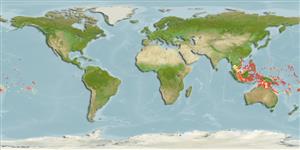Common names from other countries
Environment: milieu / climate zone / depth range / distribution range
Ekologi
marina revassocierade; djupintervall 0 - 50 m (Ref. 90102), usually 0 - 15 m (Ref. 90102). Tropical; 19°N - 24°S
Pacific Ocean: Philippines to the Society Islands, south to New Caledonia. Replaced in the western Indian Ocean by Photoblepharon steinitzi (Ref. 37816).
Size / Vikt / Age
Maturity: Lm ? range ? - ? cm
Max length : 12.0 cm TL hane/ej könsbestämd; (Ref. 9710)
Taggstrålar i ryggfenan (totalt) : 2 - 3; Mjukstrålar i ryggfenan (totalt) : 16 - 20; Taggstrålar i analfenan: 2; Mjukstrålar i analfenan: 13 - 15.
Occurs along seaward reefs near or along steep drop-offs with caves (Ref. 9710). In some areas it may approach the surface (Ref. 9710). Usually feeds in large groups away from the reefs at night. Well hidden in caves during the day and rarely seen; often observed at 10-30 m at night (Ref. 48635).
Life cycle and mating behavior
Maturities | Reproduktion | Spawnings | Egg(s) | Fecundities | Larver
McCosker, J.E. and R.H. Rosenblatt, 1987. Notes on the biology, taxonomy, and distribution of flashlight fishes (Beryciformes: Anomalopidae). Jap. J. Ichthyol. 34(2):157-164. (Ref. 5004)
IUCN Red List Status (Ref. 130435)
CITES (Ref. 128078)
Not Evaluated
Threat to humans
Harmless
Human uses
Fiskeri: saknar intresse; Akvarium: Kommersiell
Verktyg
Special reports
Download XML
Internet-källor
Estimates based on models
Preferred temperature (Ref.
115969): 26.2 - 29.3, mean 28.6 (based on 1756 cells).
Phylogenetic diversity index (Ref.
82804): PD
50 = 0.7520 [Uniqueness, from 0.5 = low to 2.0 = high].
Bayesian length-weight: a=0.01122 (0.00514 - 0.02450), b=3.04 (2.87 - 3.21), in cm Total Length, based on all LWR estimates for this body shape (Ref.
93245).
Trofisk nivå (Ref.
69278): 3.5 ±0.5 se; based on size and trophs of closest relatives
Fishing Vulnerability (Ref.
59153): Low vulnerability (10 of 100).
